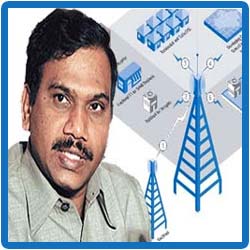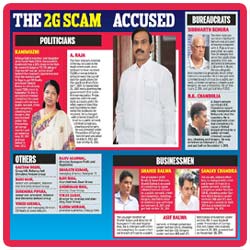HISTORY
This is one among the biggest scam in the history of political India which involved politicians and government officials against law undercharging mobile telephone companies for frequency allocation licenses, which they would then use to create 2G spectrum subscriptions for cell phones. According to a report submitted by the Comptroller and Auditor General of India based on its calculation on the auction prices on 3G and Broadband Wireless Access spectrum which was held in 2010, there was a major deficit of money collected and the amount which was assigned to be collected was about INR1766.45 billion (US$30 billion). The Central Bureau of Investigation filed a charge sheet on 2 April, 2011 stating that this has created a loss of about INR 309845.5 million (US$5.2 billion). But however on 19 August, 2011 this allegation was highly objected by the Telecom Regulatory Authority of India (TRAI) where they professed that there was a profit to the government by giving 2G spectrum which came up to INR 30 billion (US$500 million).ALLEGATION DENIED BY THE MINISTER OF COMMUNICATION & IT
This allegation was also denied by the then Minister of Communications & IT, Kapil Sibal in 2011 who explained in a press conference that by distribution of 2G licenses for those who came first had resulted in zero loss to the government which very clearly means that the frequencies were not sold for less than cost. On 2nd February, 2011 all the details of the total amount of profit, loss, and no-loss were put to rest based on Public interest litigation (PIL) concerned to the 2G spectrum scam in the Supreme Court of India. It was proclaimed by the Supreme Court that the assignment of spectrum as "unconstitutional and arbitrary" and quashed all 122 licenses issued in 2008 during the period of the then minister for communications & IT, Raja from 2007 to 2009. He was one of the main person who was charged in the 2G scam case. The Supreme Court during its verdict mentioned that A. Raja in order to help some companies for his personal benefit at the cost of the public exchequer had almost gifted away important valuables of the country.
TRIAL IN THE SUPREME COURT
However during a trial in the Supreme Court on 3 August, 2012, the zero loss theory became an out of question and the Government of India revised the base price for 5 MHz 2G spectrum auction to INR 140 billion (US$2.4 billion), leading the value of spectrum to amount to roughly INR 28 billion (US$470 million) per MHz. The amount mentioned by the Supreme Court was almost close the figure which was estimated by the Comptroller and Auditor General of India as INR 33.5 billion (US$560 million) per MHz The then minister for communications & IT, Raja manipulated the original plan in a very a clever manner where the authentic plan for awarding licenses was to follow a first-come-first-served policy to applicants which was kicked in as the license was issued on the basis of who applied first but who complied with the conditions.
HAPPENING

DETAILED - MODUS OPERANDI

THE CAG IN ITS REPORT REPRIMANDED THE TELECOM MINISTER RAJA
The CAG in its report reprimanded the telecom Minister Raja severely for not taking into consideration the advice of finance and law ministries on allocation of 2G spectrum to benefit a few operators. The Comptroller and Auditor General also mentioned that the assignment of price for the 2008 spectrum was based on 2001 prices which was extremely under- estimated and resulted in a loss to the government exchequer. The auction was not conducted in the right way and no bids were taken to sell out the spectrum. Not able to fight with the unceasing intense opposition pressure from the opposition party , the then Telecom Minister Raja finally yielded in concern with the 2G scam and was arrested by the Central Bureau of Investigation on 2nd February. There were so many private telecom service providers who were benefitted by this allotment of 2G license and some of the firms include Bharti, Vodafone, Idea, BSNL, Reliance and Aircel.
PEOPLE INVOLVED IN THE SCAM
Some of the politicians and Bureaucrats who were accused in the 2G spectrum scandal were:- A. Raja, the Ex-Minister of Communications and Information Technology.
- ArunShourie, the minister for Telecom during 2003 in the previous BJP regime.
- Pramod Mahajan, the minister for Telecom between 1999 and 2003.
- Siddhartha Behura, former telecom secretary who served in the Department Of Telecommunication at the time of the 2G allocation.
- Pradip Baijal, a bureaucrat who is supposed to have executed policies that favored certain Telecom companies when he was heading the TRAI.
- R K Chandolia, private secretary of Raja during UPA-I when the licenses were awarded. He was an Indian Economic Service officer.
Disclaimer:
This web page explains the scams that occurred in India.
The information are collected from the media reports.
www.indianmirror.com or it owners do not take any responsibility
for the authenticity of the contents.
Since some cases are in the court of law, we do not endorse any
cases or do not conclude on the same.If you need any changes to be done on the above information, kindly contact us with valid proof. However sincere attempt is being made to create awareness in the society against this evil and to prepare the younger generation for a corruption free India. |


